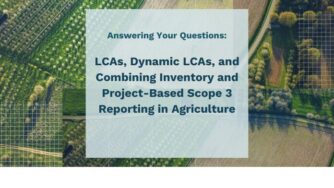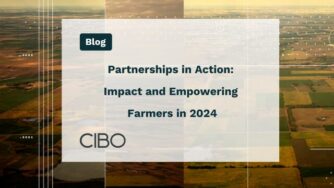In our webinar, CIBO sat down with Mollie Aronowitz, Director of Sustainability, Land Manager at Peoples Company, and George Baird, Owner of Landmark Ag Capital to discuss how to use the Leading Harvest regenerative management protocol to implement regenerative agriculture. They broke down how these practices impact farmland throughout the growing season.
Here are some of the questions this webinar answers
When it comes to regenerative programs, there are many different types. Can you share why you landed on Leading Harvest?
[MA] What’s interesting about working with a non-farming landowner, you don’t have touch points on all parts of the farming operations. That brings in how we can improve the soil’s natural ability to grow and address water and air quality issues.From our perspective, having a solid base in the midwest but knowing we wanted to expand across the country, we needed a program that would move with us in any region and crop across the US. Leading Harvest is a 3rd party verification that we can go anywhere with in the US.
Many people at Peoples Company have deep roots in agriculture. Therefore, we needed to have a broad enough framework not to limit the local producer. What shines through in leading harvest is the adaptability and flexibility to meet the producer where they need it.
[GB] What I like about Leading Harvest is that it’s driven by the consumer and the management companies. Instead of someone telling us what we should do, we’re able to collaborate on how to improve farmland forever.For example, I visited a farmer on the Chesapeake Bay. He wanted to be proactive so that he could influence the future.
Leading Harvest brings many different pieces to the table. When I sit down with farmers, we discuss why this approach is helpful versus a mandated approach. Even in one county, there may be 4-5 different farming systems based on soil, water availability, etc. We help look holistically at a farm and help share guidelines and best practices. We’re the boots on the ground and how it’s impacting landowners, investors and producers day to day.
How do you balance the holistic view of the farm with the annual or seasonable requirements to grow, market, and sell the crop?
[MA] This started to hit home for us five years ago. We were looking at traditional farm management, and a lot was put on the farmer when it came to water and conservation practices. There also wasn’t a lot of transparency between the landowner and the tenant.Peoples Company started to do research and collect data on our farms. We found that in many traditional row crop farms in the midwest, there were parts of it that were underperforming. We found spots that were losing money, and we were backing into environmental problems on the farm. Layering the economics and the environment brought a lot of clarity to the farm on how to move forward and be more profitable.
[GB] It’s really come to the forefront in the last 6-12 months. We’ve been looking at it for years but now regenerative agriculture, sustainable agriculture, and others are coming to the top of peoples interest.Every day you tune into CNBC, and you hear them talking about carbon and carbon sequestration. Then you turn the channel and hear about floods or fire. These are all coming together.
We see different groups come in from the investor side, and funding comes available to set up regenerative agriculture operations. The consumers are driving it. Food providers are heading the call and are looking for ways to bring sustainable crops to the market.
As a farmer, you can’t say no but need to ask how to make it. Farmers are taking steps each month or year to get their operation where they want to be.
Where’s the best place to start and fit regenerative agriculture into the growing schedule?
[MA] Leading Harvest works for us because they focus on continuous improvement. It’s taking steps over time and knowing where you’re starting. That’s where we start first with landowners and tenants. We do a true assessment of the farm and take a thoughtful look we build a plan for the steps we can take next year. We’re usually thinking in a year cycle.We also set short and long-term goals to have a good sense of direction of where the farm should go in the future.
How are you balancing the economic and environmental benefits and drawbacks to regenerative agriculture?
[MA] Some of these conservation practices don’t have an immediate benefit to the tenants. A one year cover crop, the tenant isn’t going to see it the same way they will in 5 to 10 years. A farmer on a one-year cash rent lease doesn’t have the incentive to invest in long-term regenerative practices.We’ll try to find a balance if it’s the landowner helping with the financial burden or if it’s a longer-term lease, the tenant sees the benefit.



